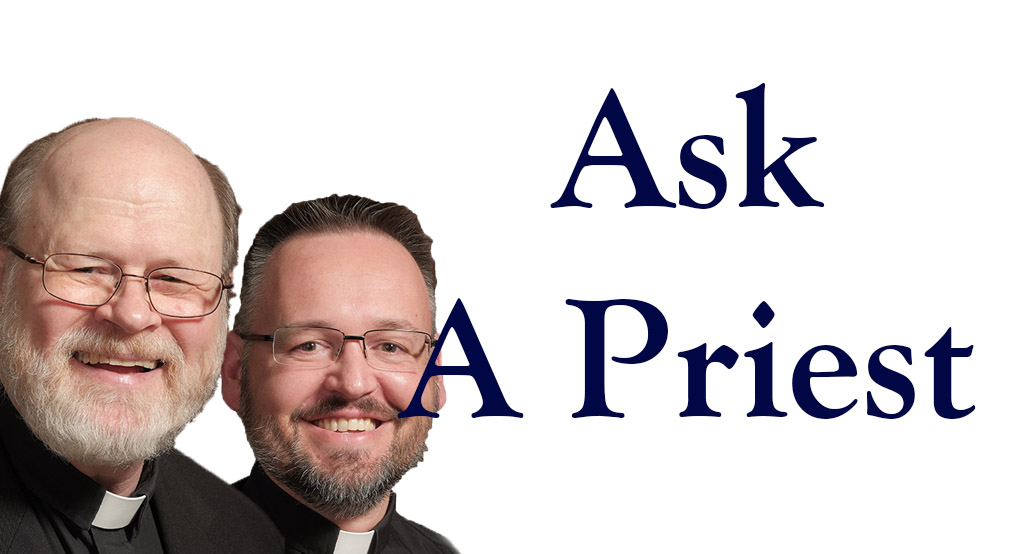Response from: Both Fr. Stephen and Fr. Jim
Response:
Yours is an excellent question – thank you. The reason for this reference to her as a prostitute is a matter of some historical development and biblical interpretation.
Let’s begin with the biblical record. The name “Mary Magdalene” (or “Mary, called Magdalene”) is mentioned 12 times in the Gospels of Matthew (27:56; 27:61; 28:1), Mark (15:40; 15:47; 16:1; 16:9), Luke (8:2; 24:10) and John (19:25; 20:1; 20:18). This, incidentally, is more often than any of the twelve apostles, except for Peter. We are introduced to her in Luke 8: 1-2 where she is identified as one of the women who followed and served Jesus during his ministry throughout Galilee. After this, all the Gospels record that she witnessed the crucifixion and burial of Christ. Then, early on the third day, she joins some other women in going to the tomb to anoint the body of Jesus. The Gospel of John has her going there alone. In 20:11-18, John records a wonderfully moving scene between Jesus and Mary in the garden of the tomb where the Lord instructs her to announce to the apostles that he was ascending to God.
From these accounts, we see that there is no association with her being called a prostitute or a sinful woman. If anything she is seen as a faithful follower of Christ, one who served him and was charged with the instruction by the Lord himself to announce the good news to the apostles. So, you are right, she is “the first of Jesus’s disciples to witness the Resurrection.” In fact, the Eastern Churches name her feast day just this way: “The Holy Myrrh-bearer and Equal-to-the-Apostles.” The tradition goes further and gives her the title: “Apostle of the Apostles.”
How then do we account for this identification of her as a prostitute or sinful woman? Just prior to the introduction of Mary Magdalene in Luke 8, we read at the end of chapter seven (verses 36 to 50) the account of an unnamed woman who comes into the house of a Pharisee who is hosting Jesus to supper. She is regarded throughout the city as a sinner, yet Jesus allows her to wash his feet with her tears, dry them with her hair, and anoint them with a fragrant oil. In the Gospel of John (12:1-11), we meet another Mary, the sister of Lazarus and Martha of Bethany, all of whom were close friends of Jesus. Sometime after Jesus had raised Lazarus from the dead, they had supper together with Mary serving. At one point she anoints his feet with a costly ointment and wipes them with her hair. You can see how close these accounts are: two women named Mary, a recognized sinner, the anointing of Jesus’ feet.
The overwhelming majority view of the Eastern Churches is that these are three separate individuals. In the West, these three individuals were merged into one person by Pope Gregory the Great who is highly regarded and influential in the East as well, and is celebrated as a saint. In a famous sermon in A.D. 591 he preached: “She whom Luke calls the sinful woman, whom John calls Mary, we believe to be the Mary from whom seven devils were ejected according to Mark.” Even though we do not agree with him on this point of identification, his influence on the Eastern Churches is not inconsiderable. Still, we must be kind to the memory of Pope Gregory. After all, he lived in a time of uncertainty, fear and anxiety: invasions, plague, famine. Perhaps he thought that the figure of a repentant Mary Magdalene could become a symbol of hope and encouragement to the Church during the Dark Ages.
It is significant to note that the Roman Church has moved in the direction of the understanding of the Eastern Churches. In 1969, Pope Paul VI removed the identifier “penitent,” which had traditionally been applied to Mary Magdalene on the Roman liturgical calendar. The readings of the day were to be taken from the Gospel passages that reflected her discipleship. In 1988, Pope John Paul II, in an apostolic letter refers to her using the ancient title “the apostle of the apostles,” and described her as one of those “women [who] proved stronger than the Apostles” at the moment of the crucifixion, remaining at Jesus’ side. Most recently, on June 10, 2016, Pope Francis directed that a decree be issued changing the status of her commemoration from a memorial to the level of a feast in the General Roman Calendar. You can read more about this at
Mary Magdalene, “Apostle to the Apostles,” Given Equal Dignity in Feast (aleteia.org).
Perhaps we can take courage from someone whom history has regarded as a model of repentance (which in itself is not insignificant) and now is acknowledged by both East and West as a model of discipleship and an assurance of the dignity of women.
In the hymn for her feast in the Eastern Churches, we pray for her intercession in these words:
Let us all sing a hymn of praise and a special canticle to the disciple of Christ, Mary Magdalene, the first myrrh-bearing woman, for she was a messenger of joy to the apostles. Let us praise the God of all who lavished upon us and upon the world such a fountain of wonders and miracles.
In Christ’s peace,
Father Stephen Wojcichowsky
The Church recalls the memory of the holy myrrh bearer and equal of the apostles, Mary Magdalene.
There are several Marys’ mentioned in the New Testament. The surname Magdalene distinguishes this Mary as the one from the town of Magdala. Luke’s gospel mentions that Jesus relieved her of seven devils, which could have simply been some kind of physical or mental illness… (source: http://stmichaelukrainian.org/tag/st-mary-magdalene/)

